Shih Tzu
Breed Traits and Characteristics
According to the American Kennel Club, here are some breed characteristic you can find in Shih Tzus.
- Height
9-10.5 inches
- Weight
9-16 pounds
- Life Expectancy
10-18 years
- Coat Type/Length
Double/Long
-
100 affectionate with family
-
100 good with young children
-
100 good with other dogs
-
80 trainability level
-
60 energy level
-
60 barking level
-
20 shedding level
-
20 drooling level
The Shih Tzu
The Shih Tzu is quickly becoming one of the most popular small dog breeds as the number of Shih Tzu we are seeing for dog training is rapidly increasing. In the world of small breeds, this is one of the cutest breeds and unlike the Yorkshire Terrier, is not usually looking for a fight. The Shih Tzu has a reputation for getting along with most dogs that it meets.
Bred to be lap dogs of Chinese Emperors, they love nothing better than snuggling with you. They will worm their way into your heart and will let you know what they want from you and when, which usually means to just be curled up on your lap in front of the fire or TV.
They are not overly demanding, but their barking can be a big issue and needs to be addressed as quickly as possible or it will drive you to distraction. At least you need to be able to turn them off. This breed will just want to be pampered, nestled on your lap. If you do not want a lap dog, this might not be the right breed for you.
Bark Busters trainers train hundreds of this breed each year and our methods suit their sweet nature and friendly disposition.
Shih Tzu Management
The Shih Tzu is a highly intelligent breed and they will know what you are about to do, possibly before you do. They are very trainable and love learning new things, but they can train their owners far quicker than their owners can train them.
Before you know it, they will lead you to the pantry for a treat and then back to the couch for a cuddle, then out the door for a walk, leaving you wondering whose idea this was.
They love their daily walks and will be much loved by everyone they meet. They will easily fraternize with other dogs, providing they have not had a bad experience as a puppy.
Bad experiences stay with Shih Tzu’s and any trauma they have incurred is carried around with them like baggage. Because they are not generally fighters, they prefer to try avoidance over engaging the perceived enemy.
Although small in stature, they can perform tasks as easily as breeds twice their size, like obedience and agility competitions. However, they don’t cope too well with the hot weather.
This breed is easy to manage as they are small and generally obliging, but they need your attention and don’t like to be ignored. Despite their high level of intelligence, they do adapt to just lazing about and are happy to just be your companion, following you around.
If you have a Shih Tzu or are thinking of getting one, then make sure you have time to spend with them. They will want to be soaking up the love and sitting on your lap a lot, because they want the reassurance that you are there for them.
Most Shih Tzu parents have them clipped in the summer to help them cope with the heat. Their dense coat means that they will need regular flea and tick treatments, so speak to your vet for more information. You will need to ensure that your Shih Tzu has regular vet checks to ensure they stay healthy.
Shih Tzu Breed Traits
Capabilities of the Breed
- Great all round, fun dog for all the family
- Loves to play and romp
- Great travelling companion-compact and adaptable
- Capable of competing in obedience competitions
- Good walking companion, easy to manage and control
- Great dog for the elderly
- Suitable for apartments and condominiums
Personality & Temperament
The Shih Tzu is lovable, adorable, cuddly and full of fun. They have a very stable temperament that adapts quite easily to change and different environments and circumstances.
This stability possibly stems from their breeding as a lap dog, a dog to be pampered, preened and adored, unlike other toy breeds that were bred to catch and kill other animals.
They are capable of fitting into most households and family situations, happy to. Just romp with the kids or soak up the love.
Good breeding is important to ensure your dog has the right personality and temperament to suit yours. They can be hard to find in rescues and shelters because they are one of the first breeds to be adopted!
They are a very trusting breed and generally love everyone and with some training and communication, they will make a great companion and great family dog.
Other Breed Traits
- Loyal, trustworthy and affectionate
- Confident and outgoing
- Great family dog
- Lap dog, loves to be pampered
- Good energy levels
- Not typically aggressive unless provoked
- May want to guard their toys and possessions, fixed easily with training
- Cute as buttons, little or no shedding
- Highly intelligent and adapts to training if you are persistent
- Level of barking is high with this breed
- No shedding, but coat needs regular grooming and clipping
Training Your Shih Tzu
The right training for your Shih Tzu
You might experience some chewing when your Shih Tzu is a young puppy, but that will soon pass. They do love to play with soft chewy toys and squeaky toys. Chewing will not be your biggest challenge - barking and refusal to come to you might be.
You might also experience some guarding issues. They tend to want to protect what is theirs, or what they consider to be theirs.
All dogs, regardless of breed, need their education and some basic training. We know that your dog is like your child and the type of education you choose has to be the very best type of education for you and your dog.
Bark Busters tailors all training to your dog’s personality and your needs. You cannot just trust your dog’s education to just any dog trainer. They need someone who understands the breed, their personality and how to get the best from them in a gentle and kind way.
To train a Shih Tzu, you have to establish your rules first and then stick to them. Consistency and routine is the key. Is your dog going to be allowed in your bed, or on your couch? Then once you have your ‘rules list’, set about making sure your dog knows what the rules are and be consistent.
Bark Busters believes that dogs are predisposed and hard-wired at birth, to want to belong to a social group that has a strong leader at its core. It’s what makes them feel secure, safe, and less anxious, knowing that their needs are going to be met. This is why dogs like to form strong bonds with humans and other animals. It’s in their DNA to want to be part of a strong social group.
A dog really needs that ‘vacation mind’ and the feeling that it is always in vacation mode. You know that feeling you have when you are on vacation, you don’t have a care in the world, you don’t are free from all your woes. When on vacation, you feel like you have left all your cares behind you at home and now you can finally relax and enjoy yourself. This is the way your dog should feel all the time. It’s the best frame of mind for all dogs, because it means you are taking care of things for them, and have their back.
Bark Busters training employs no force, no pain, only ‘communication’. We speak to dogs in a language they understand, a language they learned at birth. It’s ‘dog language’ and they respond almost immediately. We ‘train the brain’ and look for signs that the dog understands what we are communicating. We look for the dog’s cooperation and understanding that it knows what we are asking it to do.
Show and Guide
At Bark Busters, we believe that there should be no force involved in training and that hands should only be used for praise. Your dog should never fear being touched by you, they need to know that your hands mean kindness, not pain.
We teach dog parents how to show and guide their dog to make better choices. There is never any need to use force.
The use of treats as a way to train dogs has become very popular in the last 20 years and may seem like the right choice. However, many dogs either come and take the treat, then run off or they don’t care about food, and don’t respond.
Either way, the treats have their limitations and that type of training does not offer the complete answer for all dogs for all behavioral issues or training needs. Many doggie parents are happy to hear that Bark Busters training does not rely on the use of treats as they are tired of carrying pockets full of treats in order to get their dog to comply with their wishes.
Bark Busters will use treats sparingly if a case calls for it or if a dog’s personality calls for their use, but it’s not our main source of training. We only use treats when required and or when the need arises.
The main core of our training program is ‘canine communication’. This allows the dog owner to gain fast results, because this is the dog’s first language. Speaking dog is learned from their mum and litter mates. Human language is the dog’s second language. They can learn to understand the human language, but it takes time and repetition.
Our training is based on building trust, respect and forming a strong bond between a dog and human. By using voice tones and body language, you will have a well-trained dog in no time. Most pet parents see amazing results after the first lesson.
Come When Called
The “Recall” or “Come When Called” issue is quite often a case where the dog dislikes going to their human because their human has grabbed them with their hands when they approached, or they immediately made them sit or put them outside.
This creates a miscommunication in the dog’s mind that it will feel uncomfortable when it approaches the human, so they avoid that and stay away.
Many people think that their dog is being stubborn or cantankerous if they don’t respond to “come” or “sit”. Actually, they are just practicing avoidance of something they have long since learned caused them discomfort.
If you want your dog to come when called, then make sure that you always greet them in a nice and gentle way, give them lots of praise and don’t go straight to carrying out an action that was the reason you called them. Praise and pet them when they arrive, don’t grab them, or immediately clip a leash to them. Instead, spend some time greeting them. Also let them wander off and repeat the recall again, bringing them to you.
We have experienced cases where the human has sent the wrong messages to their dog by only calling it by its name. They generally demand that their dog return, using harsh commands, which frighten the dog or they might have previously tackled their dog out of frustration.
When commencing the ‘come when called’ (recall) exercise, you need to remember that your dog does not understand your language, but it can interpret body language. Crouch and raise your voice a few octaves and make encouraging high-pitched sounds. Never demand that your dog come. That is not the way to win him over and to make him want to approach you.
If you want your dog to “come” when called, negative reinforcement will not work. Your dog must feel that it can approach you without fear or concern.
It is probably not your intention to scare your dog, but is an unforeseen consequence of harsh tones. Your dog may think its name is “bad dog”.
When calling your dog, it must first want to be with you, then it must want to stay with you. How you react when your dog approaches will depend on whether they want to stay and spend time.
It is very important to keep the invitation to approach appealing, in a high-pitched enticing voice, and lower your height. Don’t forget to offer lots of praise when they arrive. You can then take them to the treat jar and treat them, but this must only be after they have been praised for coming when called.
Don’t grab your dog’s collar, or try to hang onto him, because this will cause your dog to try and avoid your hands.
Never chase your dog if it refuses to approach you. That will only cause your dog to run away and possibly hide, causing a bad association. It is better to move backwards and away, while lowering your height, or even lay down.
Bark Busters International Head Trainer Donna Ryan on the Shih Tzu
Shih Tzu’s are one of my favorites. Being the doggie parent of two large dogs, it is great when I have a toy breed like a Shih Tzu to train.
They are a loving breed, want to please and just be close to you, which works well for me as a trainer.
I have never found the Shih Tzu to be a pushy breed. They will stand back and allow the bigger dogs control, but then they give you that look that says, get me some loving and some lap time please and funnily enough you want to oblige.
I do counsel the parents of Shih Tzu’s on the risks involved in over-indulging them as they are so sweet that they tend to worm their way into your heart and can be spoiled.
Their coat needs regular attention and I do recommend daily brushing to keep their fur clear of any tangles. If left unattended for too long, they need expert attention from the groomer and some serious clipping to return their coat to its former glory. If you don’t like grooming or brushing regularly, you can keep your Shih Tzu clipped, but you will then need a coat for warmth during the winter. But clipping largely takes away the cuteness and cuddly factor of this breed.
This breed loves to cuddle up on your lap and be where everything happens, but do practice some separation time or you can create problems with Separation Anxiety.
If you are consistent, you will have no problem training your Shih Tzu. They love to learn new things and if you are patient, you can get the best out of them. They are people pleasers!
Case History of Separation Anxiety
Carly Hates to Be Left Home Alone
Carly was rescued from a shelter at the age of 6 months by Sarah and James. They wanted a dog that would be a great family dog and good with kids as they planned to have children in the near future. Meanwhile, they wanted a dog that would be able to fit into their busy lifestyle.
Carly was a great dog and she fit right in, sleeping at the foot of their bed each night and sitting on their laps every chance she got. She was like their child, and they treated her just like their child, looking to give her everything her heart desired.
Sarah told us that Carly hated being left alone, sulking each time they left the house, but she soon settled and waited anxiously for their return.
She would then greet them wildly on their return, as if they had been gone for weeks. Apart from that, their lives together were fun and Carly was always just one step behind them, asleep on their lap or asleep in their bed. She was so loving, they saw no reason not to give her everything she wanted.
Sarah noticed that things started to change when Carly was about 12-months of age. She started barking at them as they tried to leave, even nipping their ankles as they tried to push her back with their feet. She also would bark for hours after they left for work and soon the neighbours began complaining.
Sarah and James were confused as to why she had suddenly gone from being so good, to being so bad.
They spoke to some of their friends who told them that Carly suffered from Separation Anxiety and that they should contact Bark Busters. So, they decided to give us a call.
This 12-month milestone in dogs usually coincides with reaching maturity. They hit that age of maturity, full grown, where they are now ready to work out the pecking order and to work out where they fit in the family unit, their position in the household, if you like. What they decide depends on how we behave and what we tell them via our actions and behavior.
Carly had learned, over time, through Sarah and James’s behavior around her, that she was the ‘queen bee’ and the one calling the shots. How dare they leave her behind? Didn’t they know she was in charge? This was why she was barking and biting them when they tried to leave her. She was telling them in dog language, that she was not pleased with their behavior.
The reason she took so long to get to that point was due to her lack of maturity. Until 12 months, she was not ready to act to claim her position until she reached the maturity needed to hold that position.
Sarah and James had never educated or trained Carly at all, they had not displayed any leadership qualities with her, preferring to just shower her with love and adoration. There was a position at the top vacant and Carly was now applying for the job.
Sarah and James had also made another fatal mistake of never separating from her when they were home. She slept in their bed, sat on their laps, and followed them from room to room, making the only time they left her alone was when they left for work.
This is one of the main causes of Separation Anxiety and Carly’s behavior is consistent with dogs that suffer this behavioral issue. It’s the result of lack of education and leadership and a failure to practice separation while at home.
Bark Busters showed Sarah and James how to easily fix their problems with Carly, through basic exercises that subtly changed the balance of power in a kind, gentle but effective way and it worked. Dogs like Carly are happy to fall in line once things are brought back to a proper balance.
Carly was not a bad dog. She was just confused, as her dog owners led her to believe that she was in charge. She never wanted them to leave her.
Footnote: All dogs are hard-wired at birth to fill a leadership void. If one exits, they will try and exert control. It is up to dog owners to assume the leadership role.
Every dog needs to learn to separate from its pet parents. This can be addressed by practicing separation while at home. Love alone is not enough to have a happy, well- balanced dog. We all love our dogs, but we also want them to be happy when everyone is not together. They need to learn to cope with our absence.
Shih Tzu Common Behavioral Issues
Barking
When Bark Busters gets the call to train a Shih Tzu, it will be for one of several specific reasons: barking, aggression to their family, biting the groomer or playing a little too hard at the doggy-day-care center.
Apart from the barking which is inherent to the breed, most of the behavioral issues we are called upon to deal with originate in bad experiences versus breed traits.
As we have said, Shih Tzu barking can seem out-of-control. They tend to bark at people and dogs passing the window, or off in the distance when walking. They love to bark at the front door when visitors arrive as if saying please pet me, bark.
Barking while travelling in the car can be a problem that is easily rectified. Dogs can become over-stimulated in cars as images do go flashing by. You could try adding a crate to your vehicle and popping your dog in their crate while you travel. To address barking, you must catch your dog in the act and let them know, via communication that what they are doing is wrong.
We have seen great success with the Bark Busters style of training to stop inappropriate and unwarranted barking.
When we see a tough case where a dog has become over-stimulated to the level of fixation, we have had success with a product called a Calming Cap (available at many stores) when coupled with our training.
Connect with Us!
Need help training your Shih Tzu? Call 1-877-500-BARK (2275)or enter your zip code.
Shih Tzu Health
Common Illnesses and Injuries
Your Shih Tzu’s health concerns will change over the course of their life. A puppy might be more prone to ear infections, a 2-year-old Shih Tzu may be more likely to show signs of dental disease, and a senior Shih Tzu may be more likely to develop eye problems later in life. Shih Tzu’s also have personality and physical traits that may make them more prone to certain conditions—the adorable short snout of the Shih Tzu makes it sensitive to warm weather and prone to heat stress.
At any stage of life, here are some of the most common injuries and illnesses you should be aware of when bringing home a Shih Tzu:
- Ear infections
- Dental disease
- Urinary tract infections
- Eye problems
- Kidney disease
- Hip dysplasia
- Bone and joint problems
- Glaucoma
If you are ever concerned about your dog’s health, your local veterinarian is a great resource—no matter how small the question.
Genetic Health Concerns
Like many popular breeds, the Shih Tzu has its fair share of hereditary based issues, like bone and joint problems. Most reputable breeders now have their breeding stock checked and scored for these hereditary ailments by a vet. You can request proof that the puppy you are purchasing comes from parents that have been checked for these issues.
Because many other health issues are also hereditary, you should do some research on the ancestry of your puppy and any health issues of that particular breed. Many rescue organizations also check for common-ailments before making them available for adoption.



